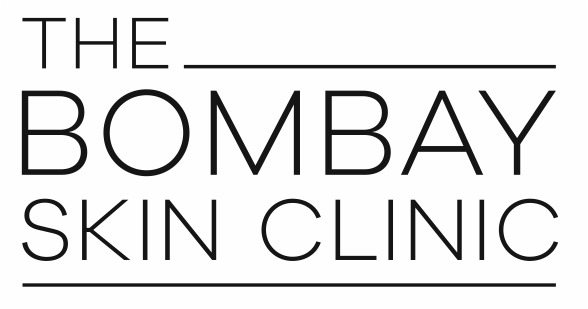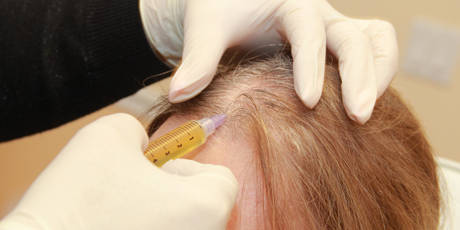Treatment | Systemic Treatments | Alternatives Therapies | Managing Hair Loss | Efficacy of Treatment
Treatment helps in quicker re-growth of hair. Often dermatologist suggests a combination of treatments for better success rates. Research is going on to check whether lasers and light therapy can work on the immune system to give the right signals for the body to start normal hair growth. Most patients sustain repeat hair loss even with treatments until the immune reaction affecting normal hair growth cycle goes away for good.
Treatment options
Corticosteroids
Corticosteroids suppress Immune system that causes alopecia and are given as
- Injection – Intralesional – directly injected into hairless patches and scalp, brows and beard areas.
- Oral corticosteroids – Used extensively but with potential side-effects like weight gain, osteoporosis, cataracts, and hypertension.
- Topical – Used as ointments, creams, applied to the affected scalp.
Minoxidil
- Topical – 5% topical solution for hair growth.
Anthralin
Synthetic tar-like material for altering immune function in the bald area
- Topical – short contact therapy.
Topical sensitizers/ Immunotherapy
Medications topically applied provoke a sharp allergic reaction causing itching sensation and scaling to stimulate dormant hair follicles.
- Diphencyprone (DPCP)
- Squaric acid dibutyl ester (SADBE)
Systemic treatments (oral and topical)
Photochemotherapy (PUVA)
Using psoralen – a photosensitive drug – either topically or orally and then exposed to ultraviolet rays in a clinical environment (A common psoriasis treatment).
Systemic steroids
- Prednisolone
- Cyclosporine (both topical and systemic)
Alternative therapies
Alternative therapies are popular like
- Vitamin supplements and Zinc.
- Evening primrose oil.
- Aromatherapy.
- Acupuncture.
- Chinese herbs.
Managing hair loss
- Manage stress – Get counseling, learn to relax with meditation, tai chi etc.
- Conceal the bald patches with cosmetic enhancements
- Hairpieces made of human hair or synthetic stuff – attached with glue/clips to scalp. Hair weaving is not advised.
- Using techniques like perms for making hair look thicker; dyes for coloring scalp.
- Protect from excessive sun exposure when going out
- Use sunscreen lotion.
- Cover your head with wig, scarves, and caps.
- Use sunglasses with slightly larger frame that covers to protect eyes from sun as well dust.
- Keep nostrils moist and protected from dust, bacteria and other germs.
- Find social support – Enroll in a support group.
Efficacy of treatment
Efficacy of treatment given must be checked for
- Hair re-growth.
- Recurring hair-loss.
- Spontaneous remission.
Alopecia areata is not a critical or life-threatening medical condition. Though loss of hair/baldness may be equated to loss of youth, alopecia does not impair health. With treatment and cosmetic enhancements, it can be successfully treated.
-
- American Academy of Dermatology – Alopecia Areata: Diagnosis Treatment and Outcome view
- American Academy of Dermatology – Alopecia Areata Tips for Managing view
- MedicineNet – About Alopecia view
- National Institue of Health – Alopecia Areata view
- Dermatology – About.com (Heather Brannon, MD) view
- Medscape – Drugs, Diseases and Procedures [Alopecia Areata – Author: Chantal Bolduc, MD, FRCP(C); Chief Editor: Dirk M Elston, MD] view


 Dr. Batul Patel is a celebrity dermatologist and the medical director of The Bombay Skin Clinic an award winning clinic located in South Mumbai & Bandra. She is a passionate and dedicated dermatologist with expertise in all fields of dermatology, trichology and aesthetic dermatology. She has been practicing for more than a decade. Her range of expertise include emsculpt NEO, coolsculpting, fillers, acne treatment, lasers, skin rejuvenation, hair loss, hair transplant, PRP & pigmentation treatments.
Dr. Batul Patel is a celebrity dermatologist and the medical director of The Bombay Skin Clinic an award winning clinic located in South Mumbai & Bandra. She is a passionate and dedicated dermatologist with expertise in all fields of dermatology, trichology and aesthetic dermatology. She has been practicing for more than a decade. Her range of expertise include emsculpt NEO, coolsculpting, fillers, acne treatment, lasers, skin rejuvenation, hair loss, hair transplant, PRP & pigmentation treatments.